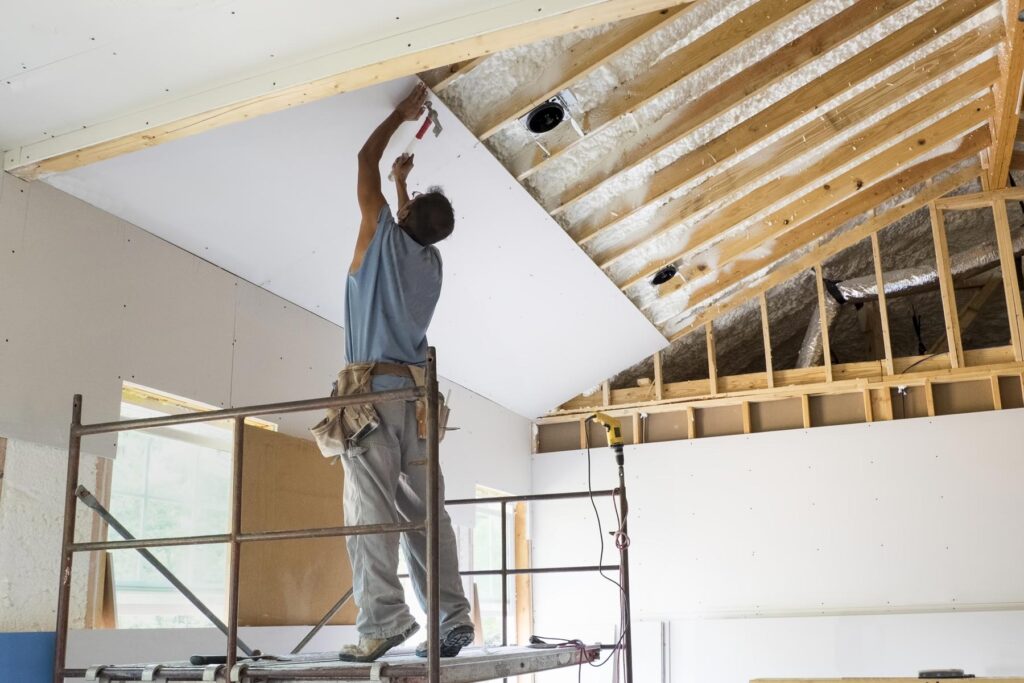Trusted Drywall Installation Solutions for every single Space
Trusted Drywall Installation Solutions for every single Space
Blog Article
Drywall Setup Facilitated: Tips for Perfect Results
Drywall installation is commonly perceived as an overwhelming job, yet with the ideal method and expertise, it can come to be a manageable undertaking. Choosing high quality products and preparing the installment area are vital initial steps that set the structure for success. Additionally, understanding techniques for reducing, hanging, and ending up drywall can dramatically influence the outcome. As we explore these vital suggestions, you might find that also the smallest changes in your technique can cause remarkably boosted outcomes, leaving you to consider how these methods can change your next task.
Choosing the Right Products
Selecting the appropriate products for drywall installation is crucial to accomplishing a durable and aesthetically pleasing surface. drywall contractor. The main component, drywall sheets, usually come in numerous densities, with 1/2-inch sheets being basic for indoor wall surfaces. For areas requiring extra dampness resistance, such as kitchen areas or restrooms, consider utilizing environment-friendly board or concrete board, which are particularly designed to stand up to humidity

Additionally, picking the best fasteners-- either screws or nails-- is essential for safeguarding the drywall to the framework. Drywall screws are usually preferred for their holding power and reduced threat of popping. Finally, think about the complements such as guide and paint, which not just boost the appearance however also safeguard the drywall from moisture and wear.
Preparing the Installation Area
Prior to starting the drywall installment procedure, it is necessary to prepare the installation location completely. This prep work includes numerous critical steps to make sure a successful and smooth job. Clear the area of any furniture, home appliances, or obstructions that can hinder accessibility. A tidy work area decreases the threat of damages to existing products and enables effective activity during setup.
Next, evaluate the walls and ceiling for any imperfections, such as fractures, openings, or mold. Address these issues beforehand; patch any damages and permit adequate time for repair services to completely dry. In addition, make certain that electric outlets, buttons, and pipes are effectively positioned and represented, as this will affect drywall positioning.
Think about the environmental conditions. A stable temperature and humidity level are crucial for ideal adhesion and efficiency of the drywall products. If required, utilize a dehumidifier or heating system to develop ideal problems.
Trimming and Hanging Drywall
The secret to reliable drywall installation depends on the accurate cutting and dangling of the panels. Begin by measuring the room accurately, thinking about any obstructions such as electric outlets or windows. Use a straight edge and an energy blade to score the drywall along your measurements, then break it along the racked up line for a clean break. For more intricate cuts, such as around electrical outlets, a drywall saw can be used for precision.

Constantly function from the top down and entrusted to right, guaranteeing that you maintain a staggered pattern to boost stability. Correctly hanging the drywall establishes the foundation for a smooth finish, eventually leading to remarkable cause your drywall project.
Insulation and Mudding Methods
While correct cutting and hanging of drywall establishes the stage, the following vital action involves understanding taping and mudding methods to make certain a smooth finish. Taping is important for strengthening joints and preventing cracks; it includes installing tape into the used joint substance (mud) Start with a top quality fiberglass or paper tape, using the tape over the joint and pushing it right into the wet mud making use of a taping blade, making sure no air bubbles continue to be.
When the tape is in location, apply a slim layer of joint substance over the tape, feathering the edges to produce a smooth change to the drywall surface area. Permit this layer to dry completely prior to sanding it lightly to remove imperfections. Repeat this process, applying added layers of mud as necessary-- generally a couple of coats-- while slowly widening the application area with each layer to accomplish a seamless appearance.
After the final coat dries visit this site right here out, sand the surface area with a fine-grit sandpaper up until smooth. sheetrock repair fort worth. Keep in mind to use a mask during sanding to prevent inhaling dirt particles. Mastering these taping and mudding techniques is vital for achieving a professional-quality coating in your drywall installation
Finishing Touches for Excellence
Accomplishing a flawless drywall installation exceeds mudding and taping; it culminates in the ending up touches that elevate the overall visit the site appearance. These final steps are essential in guaranteeing a professional-grade finish that improves the appearances of your room.
Begin by sanding the dried out joint compound to create a smooth surface. Utilize a fine-grit sandpaper and a sanding block or pole sander for optimum control. Pay particular attention to edges and sides, as these locations often tend to call for even more precise work. After sanding, wipe down the wall surfaces with a wet fabric to remove any type of dust particles, guaranteeing a tidy surface for paint.
Next, apply a guide especially created for drywall. This action is necessary, as it helps secure the joint compound and supplies a consistent base for the topcoat. Once the guide dries, examine for any imperfections, and touch up as needed.
Final Thought
Finally, successful drywall setup depends upon the careful choice of materials, extensive preparation of the setup area, and specific execution of reducing and hanging methods. Proficiency of taping and mudding procedures is important for attaining a smooth finish. Furthermore, attention to completing touches, consisting of priming and touch-ups, makes sure a professional-grade result. By adhering to these standards, the quality of workmanship can be significantly enhanced, adding to the total aesthetic and functionality of the space.
Drywall installation is commonly viewed as an overwhelming discover this info here job, yet with the appropriate strategy and expertise, it can come to be a convenient endeavor.Picking the suitable products for drywall setup is essential to accomplishing a durable and aesthetically pleasing finish.Prior to beginning the drywall installation process, it is essential to prepare the installation area thoroughly. Understanding these taping and mudding strategies is critical for attaining a professional-quality finish in your drywall setup.
In conclusion, effective drywall installment pivots on the careful selection of products, thorough preparation of the installment area, and precise implementation of reducing and hanging strategies.
Report this page